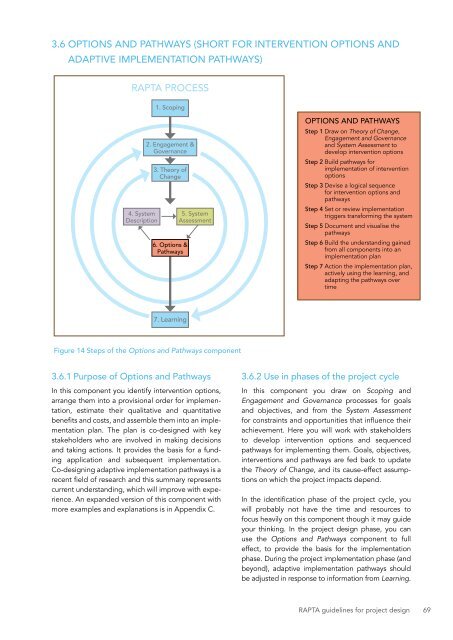DESIGNING PROJECTS IN A RAPIDLY CHANGING WORLD
srun3013fp1
srun3013fp1
Create successful ePaper yourself
Turn your PDF publications into a flip-book with our unique Google optimized e-Paper software.
3.6 OPTIONS AND PATHWAYS (SHORT FOR <strong>IN</strong>TERVENTION OPTIONS AND<br />
ADAPTIVE IMPLEMENTATION PATHWAYS)<br />
RAPTA PROCESS<br />
1. Scoping<br />
4. System<br />
Description<br />
2. Engagement &<br />
Governance<br />
3. Theory of<br />
Change<br />
6. Options &<br />
Pathways<br />
5. System<br />
Assessment<br />
OPTIONS AND PATHWAYS<br />
Step 1 Draw on Theory of Change,<br />
Engagement and Governance<br />
and System Assessment to<br />
develop intervention options<br />
Step 2 Build pathways for<br />
implementation of intervention<br />
options<br />
Step 3 Devise a logical sequence<br />
for intervention options and<br />
pathways<br />
Step 4 Set or review implementation<br />
triggers transforming the system<br />
Step 5 Document and visualise the<br />
pathways<br />
Step 6 Build the understanding gained<br />
from all components into an<br />
implementation plan<br />
Step 7 Action the implementation plan,<br />
actively using the learning, and<br />
adapting the pathways over<br />
time<br />
7. Learning<br />
Figure 14 Steps of the Options and Pathways component<br />
3.6.1 Purpose of Options and Pathways<br />
In this component you identify intervention options,<br />
arrange them into a provisional order for implementation,<br />
estimate their qualitative and quantitative<br />
benefits and costs, and assemble them into an implementation<br />
plan. The plan is co-designed with key<br />
stakeholders who are involved in making decisions<br />
and taking actions. It provides the basis for a funding<br />
application and subsequent implementation.<br />
Co-designing adaptive implementation pathways is a<br />
recent field of research and this summary represents<br />
current understanding, which will improve with experience.<br />
An expanded version of this component with<br />
more examples and explanations is in Appendix C.<br />
3.6.2 Use in phases of the project cycle<br />
In this component you draw on Scoping and<br />
Engagement and Governance processes for goals<br />
and objectives, and from the System Assessment<br />
for constraints and opportunities that influence their<br />
achievement. Here you will work with stakeholders<br />
to develop intervention options and sequenced<br />
pathways for implementing them. Goals, objectives,<br />
interventions and pathways are fed back to update<br />
the Theory of Change, and its cause-effect assumptions<br />
on which the project impacts depend.<br />
In the identification phase of the project cycle, you<br />
will probably not have the time and resources to<br />
focus heavily on this component though it may guide<br />
your thinking. In the project design phase, you can<br />
use the Options and Pathways component to full<br />
effect, to provide the basis for the implementation<br />
phase. During the project implementation phase (and<br />
beyond), adaptive implementation pathways should<br />
be adjusted in response to information from Learning.<br />
RAPTA guidelines for project design 69


